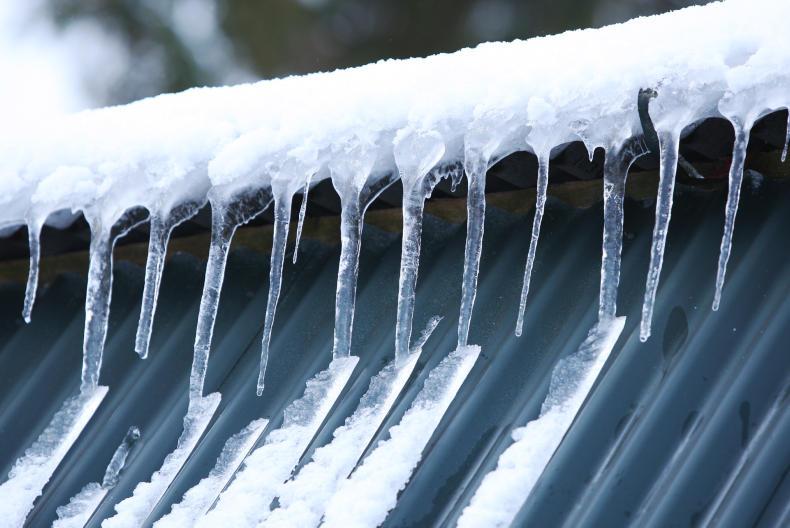The EPA has advised farmers and other rural dwellers that private wells affected by last week’s weather need proper disinfection before being used for drinking water. Disinfection should be carried out once the flooding has subsided, it said.
It outlined a disinfection procedure which will treat a well water supply, water storage tank, water-carrying pipework and hot and cold-water cylinders. Approximately 1,100 litres of water will be used. The procedure is:
Add 5 litres of a 1% w/v solution of sodium hypochlorite to 25 litres of water. The following products may be used diluted in 25 litres of water.
1. 2.5 litres of Milton fluid (or 50 tablets) or similar products with 2% w/v sodium hypochlorite.
or
2. 0.5 litres of Sterichlor or similar products with 10/11% sodium hypochlorite.
Disinfection products sold for use on the farm will be acceptable for use in disinfecting wells, the EPA statement said. However, it is important to seek advice about their use and it is advisable to always use the products in about 25 litres of water.
Pour half of the solution into the well.Turn on the drinking water tap in the kitchen and let the water run until there is a distinct smell of chlorine from the water. Then turn off the tap.Turn on all other taps and let the water run until there is a distinct smell of chlorine from the water. Then turn off the taps.Pour the other half of the solution into the well. Turn off the well pump and ensure the well is covered properly. Allow to stand overnight or for at least eight hours.After at least eight hours, reconnect the pump. Turn on all taps and let the water run until the smell of chlorine is gone. Turn off all taps.Arrange for the water to be tested.The EPA said the above method is only suitable as a once-off shock disinfecting procedure and cannot replace a proper treatment system if your water supply needs continuous disinfection.
It also noted that if there is a filter or any other type of water treatment on any part of the system, the owner should consult the supplier before following the above procedure. “Heavily chlorinated water may affect the filter or the chlorine may be absorbed by the filter, rendering the procedure ineffective,” it said.
Read more
Monday Management: dealing with the aftermath of snow storm
Monday management: no rush back into the fields as the snow melts
The EPA has advised farmers and other rural dwellers that private wells affected by last week’s weather need proper disinfection before being used for drinking water. Disinfection should be carried out once the flooding has subsided, it said.
It outlined a disinfection procedure which will treat a well water supply, water storage tank, water-carrying pipework and hot and cold-water cylinders. Approximately 1,100 litres of water will be used. The procedure is:
Add 5 litres of a 1% w/v solution of sodium hypochlorite to 25 litres of water. The following products may be used diluted in 25 litres of water.1. 2.5 litres of Milton fluid (or 50 tablets) or similar products with 2% w/v sodium hypochlorite.
or
2. 0.5 litres of Sterichlor or similar products with 10/11% sodium hypochlorite.
Disinfection products sold for use on the farm will be acceptable for use in disinfecting wells, the EPA statement said. However, it is important to seek advice about their use and it is advisable to always use the products in about 25 litres of water.
Pour half of the solution into the well.Turn on the drinking water tap in the kitchen and let the water run until there is a distinct smell of chlorine from the water. Then turn off the tap.Turn on all other taps and let the water run until there is a distinct smell of chlorine from the water. Then turn off the taps.Pour the other half of the solution into the well. Turn off the well pump and ensure the well is covered properly. Allow to stand overnight or for at least eight hours.After at least eight hours, reconnect the pump. Turn on all taps and let the water run until the smell of chlorine is gone. Turn off all taps.Arrange for the water to be tested.The EPA said the above method is only suitable as a once-off shock disinfecting procedure and cannot replace a proper treatment system if your water supply needs continuous disinfection.
It also noted that if there is a filter or any other type of water treatment on any part of the system, the owner should consult the supplier before following the above procedure. “Heavily chlorinated water may affect the filter or the chlorine may be absorbed by the filter, rendering the procedure ineffective,” it said.
Read more
Monday Management: dealing with the aftermath of snow storm
Monday management: no rush back into the fields as the snow melts






 This is a subscriber-only article
This is a subscriber-only article





SHARING OPTIONS: